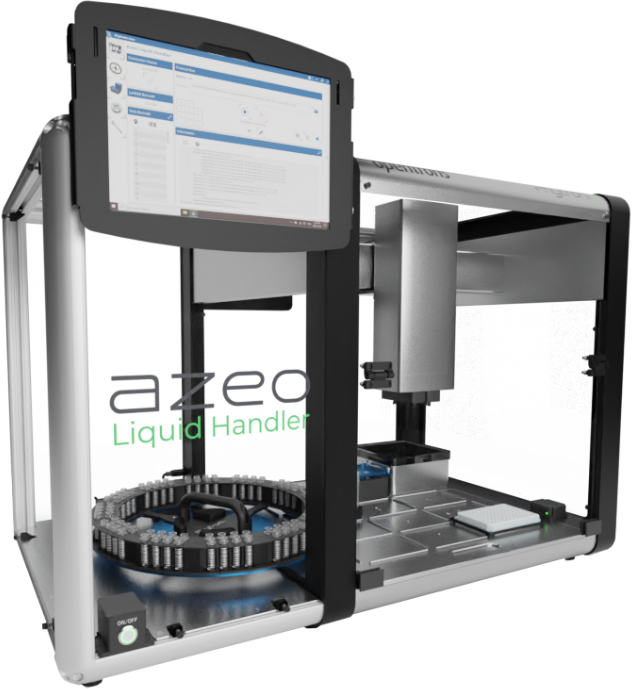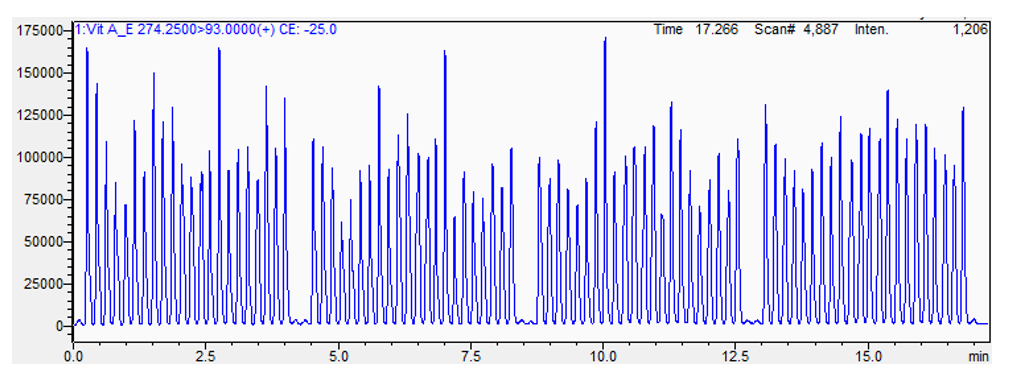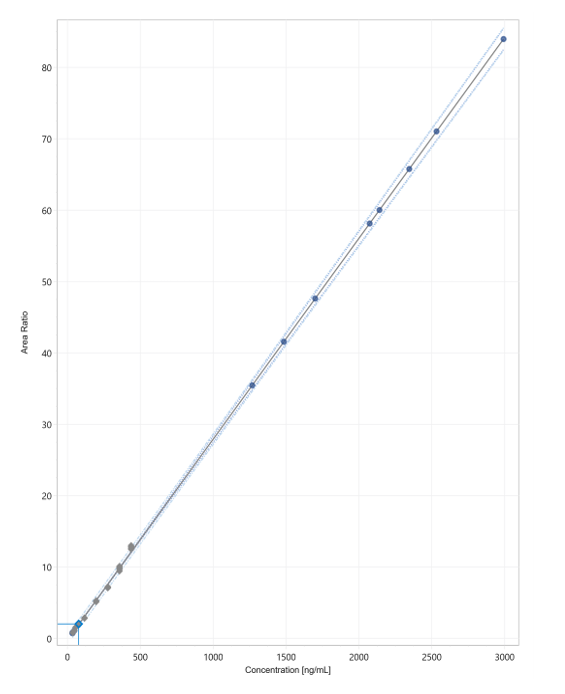Introduction
Vitamin A (Retinol) and E (Tocopherol) have important roles in physiological functions to maintain good health. Scientific publications report their potential implication in different pathogenesis caused by the oxidative stress. Their role as biomarkers is evaluated. For large epidemiologic studies, high-throughput and accurate analytical techniques are needed. Our goal for this application note is to use an automated sample preparation method for the quantification of Vitamins A and E in serum using a single operation in LDTD-MS/MS.
LDTD-MS/MS offers specificity combined with an ultra-fast analysis for an unrivaled quantification method. To develop this application, we focused on performing a quick and simple sample preparation. Vitamins A and E are analyzed, and results are obtained in less than 8 seconds per sample.
Sample Preparation Method
Automated Sample Extraction
Due to the instability of Vitamins A and E, stock solutions were prepared in ethanol (0.1% BHT). Bovine serum albumin solution (40 mg/mL) was used as the negative matrix. The BSA matrix was then spiked to generate a calibration curve and QCs.
Samples were transferred into barcoded tubes, readable by the Azeo extraction system. Each barcoded vial was scanned by the Azeo Liquid Handler and an automatic batch file was created. The Azeo extraction system (Figure 3) is used to extract the samples using the following conditions:
- 5 µL of Internal standard (Retinol-d5 and Tocopherol-d6 at 10 mg/mL in EtOH (0.1%BHT)) were added to each sample
- 25 µL of serum sample were transferred from the vials to a deep-well plate placed in the Lumo Vortexer
- Mix (30 seconds at 1000 rpm)
- 25 µL of extraction buffer (0.25 mM NaOH in IPA:Water / 3.5:7.5) were added into a deep-well plate
- Mix (30 seconds at 1000 rpm)
- 300 µL Hexane were added into a deep-well plate
- Mix for 5 minutes at 1000 rpm
- Pause of 5 minutes for phase separation
- Spot 6 µL upper layer phase onto a LazWell™ 96 plate
- Dry 1 minute at room temperature with air flow.
- Spot 6 µL Butylated Hydroxytoluene (BHT, 100 µg/mL in hexane) onto a LazWell™ 96 plate
- Dry 1 minute at room temperature with air flow.

LDTD®-MS/MS Parameters |
|||||||||||||||||||||||||||||||||||||||||||||||
| Shimamdzu | Thermo | Sciex | |||||||||||||||||||||||||||||||||||||||||||||
|---|---|---|---|---|---|---|---|---|---|---|---|---|---|---|---|---|---|---|---|---|---|---|---|---|---|---|---|---|---|---|---|---|---|---|---|---|---|---|---|---|---|---|---|---|---|---|---|
| LDTD
Model: Luxon SH-960, Phytronix Carrier gas: 9 L/min (air) Laser pattern:
MS/MS MS model: LCMS-8060, Shimadzu Scan Time: 50 msec Total run time: 8 seconds per sample Ionization: APCI Analysis Method: Positive MRM mode |
LDTD
Model: Luxon T-960, Phytronix Carrier gas: 9 L/min (air) Laser pattern:
MS/MS MS model: Thermo Vantage, Thermo Fisher Scientific Scan Time: 50 msec Total run time: 6 seconds per sample Ionization: APCI Analysis Method: Positive MRM mode |
LDTD
Model: Luxon S-960, Phytronix Carrier gas: 9 L/min (air) Laser pattern:
MS/MS MS model: Q-Trap System® 5500, Sciex Scan Time: 40 msec Curtain: 30 Total run time: 8 seconds per sample Ionization: APCI Analysis Method: Positive MRM mode |
|||||||||||||||||||||||||||||||||||||||||||||
|
|
|||||||||||||||||||||||||||||||||||||||||||||||
|
Table 1 – MRM transitions for LDTD-MS/MS |
|||||||||||||||||||||||||||||||||||||||||||||||
| Shimadzu | Thermo | Sciex | |||||||||||||||||||||||||||||||||||||||||||||
|
|
|
|||||||||||||||||||||||||||||||||||||||||||||
The following sections are taken from the application note 2107B for Shimadzu MS. For all the applications of « Analysis Vitamin A and E in Serum as a Biomarker of Clinical Disorders » (Shimadzu,Thermo and Sciex), please download the PDF attached to this article.
Results and Discussion
Data preparation process
Mass spectrometers are data acquisition systems that were not designed to deal with signals of a few seconds per sample. The synchronization sequence adds 6 to more than 15 seconds between each sample. To bypass this, all samples are acquired in a single file (Figure 4). To allow the analysis of such data, Cascade software is designed to detect, split and integrate every sample peak acquired in a single file.

Validation Test for Vitamins A and E
Calibration curves ranging from 191 to 2191 ng/mL for Retinol and from 3.1 to 43.1 mg/mL for Tocopherol were prepared in a serum exposed to UV light. Three human serum samples were used as QCs (endogenic concentration values were evaluated with a reference method and used as a nominal value). Replicate extractions were deposited onto a LazWell™ plate and dried before analysis. The peak area against the internal standard (IS) ratio was used to normalize the signal.
Linearity
The calibration curves were plotted using the peak area ratio and the nominal concentration of standards. For the linearity test, the following acceptance criteria was used:
- Linear regression (r2) must be ≥ 0.99
Figure 5 shows a typical calibration curve result for Tocopherol. Similar results are obtained for Retinol.

Precision and Accuracy
For the accuracy and precision evaluation, the following acceptance criteria were used:
- Each concentration must not exceed 15% CV
- Each concentration must be within 100 ± 15% of the nominal concentration
For the inter-run precision and accuracy experiment, each standard was analyzed in triplicate, on five different days. Table 2 and 3 shows the inter-run precision and accuracy results for Retinol and Tocopherol, respectively. The obtained %CV was below 15% and the accuracy was within 15% of the nominal value.
Table 2 – Inter-Run Precision and Accuracy of Retinol
| Retinol | QC-L | QC-M | QC-H |
|---|---|---|---|
| Conc (ng/ml) | 391 | 991 | 1791 |
| N | 15 | 15 | 15 |
| Mean (ng/ml) | 405.0 | 942.2 | 1755.5 |
| SD | 23.1 | 63.4 | 118.8 |
| %CV | 5.7 | 6.7 | 6.8 |
| %Nom | 103.6 | 95.1 | 98.0 |
Table 3 – Inter-Run Precision and Accuracy of Tocopherol
| Tocopherol | QC-L | QC-M | QC-H |
|---|---|---|---|
| Conc (mg/ml) | 7.1 | 19.1 | 35.1 |
| N | 15 | 15 | 15 |
| Mean (mg/ml) | 7.7 | 19.6 | 33.3 |
| SD | 0.8 | 1.0 | 0.7 |
| %CV | 10.4 | 5.1 | 2.3 |
| %Nom | 108.4 | 102.5 | 94.9 |
Cross validation study
Real patients’ serum samples (N=6) have been tested with this method to correlate with results obtained by traditional LC-MS/MS. The percentage of difference between the values are evaluated. A difference below 10% is obtained. Results are reported in Table 4.
Table 4 – Cross validation result
| Vitamin A (retinol) | Vitamin E (tocopherol) | ||||||
|---|---|---|---|---|---|---|---|
| LC (ng/mL) |
Luxon (ng/mL) |
%Diff (%) |
LC (mg/mL) |
Luxo (mg/mL) |
%Diff (%) |
||
| M1 | 479 | 449 | -3.3 | 13.7 | 15.6 | 6.5 | |
| M2 | 411 | 423 | 1.4 | 10.0 | 11.1 | 5.3 | |
| M3 | 551 | 554 | 0.3 | 9.9 | 11.1 | 5.8 | |
| M4 | 581 | 538 | -3.8 | 15.2 | 17.7 | 7.5 | |
| M5 | 820 | 701 | -7.8 | 13.9 | 16.1 | 7.2 | |
| M6 | 553 | 609 | 4.7 | 10.8 | 12.2 | 6.0 | |
Conclusion
The Luxon Ion Source combined with Shimadzu LCMS-8060 mass spectrometer system allows ultra-fast (8 seconds per sample) analysis of Vitamins A and E in serum.